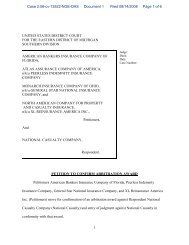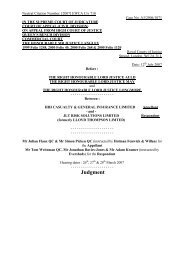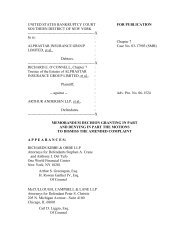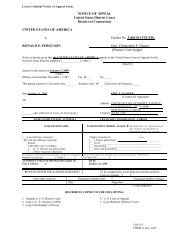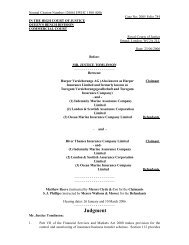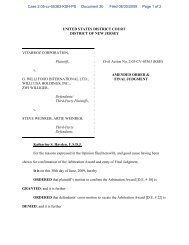Statutory Issue Paper No62R - Reinsurance Focus
Statutory Issue Paper No62R - Reinsurance Focus
Statutory Issue Paper No62R - Reinsurance Focus
You also want an ePaper? Increase the reach of your titles
YUMPU automatically turns print PDFs into web optimized ePapers that Google loves.
Property and Casualty <strong>Reinsurance</strong><br />
SSAP No. 62R<br />
control (as those terms are defined in Appendix A-440) are not eligible for the exception for property and<br />
casualty run-off agreements in subparagraph 31.e. of SSAP No. 62.<br />
Criteria<br />
69. The accounting treatment for property and casualty run-off agreements must be approved by the<br />
domiciliary regulators of the transferring entity (either the original direct insurer in the case of a<br />
reinsurance agreement or the original assuming reinsurer in the case of a retrocession agreement) and the<br />
assuming entity. If the transferring entity and assuming entity are domiciled in the same state, then the<br />
regulator of the state where the majority of the transferred liabilities is located shall be asked to approve<br />
the accounting treatment. In determining whether to approve an agreement for this accounting treatment,<br />
the regulators shall require the following:<br />
a. Assuming Entity Properly Licensed – The entity assuming the run-off agreement must<br />
have the appropriate authority or license to write the business being assumed.<br />
b. Limits and Coverages – the reinsurance or retrocession agreement shall provide the same<br />
limits and coverages that were afforded in the original insurance or reinsurance<br />
agreement.<br />
c. Non-recourse – The reinsurance or retrocession agreement shall not contain any<br />
adjustable features or profit share or retrospective rating, and there shall be no recourse<br />
(other than normal representations and warranties that would be associated with a<br />
purchase and sale agreement) directly or indirectly against the transferring entity.<br />
d. Risk Transfer – the reinsurance or retrocession agreement must meet the requirements of<br />
risk transfer as described in this statement.<br />
e. Financial Strength of Reinsurer – the assuming reinsurer shall have a financial strength<br />
rating from at least two independent rating agencies (from NAIC acceptable rating<br />
agencies) which is equal to or greater than the current ratings of the transferring entity.<br />
The lowest financial strength rating received from an NAIC acceptable rating<br />
organization rating agency will be used to compare the financial strength ratings of the<br />
transferring and assuming entities.<br />
f. Assessments – the assuming reinsurer or retrocessionaire (if required in the original<br />
reinsurance contract) shall be financially responsible for any and all assessments,<br />
including guaranty fund assessments, that are assessed against the transferring entity<br />
related to the insurance business being assumed.<br />
g. Applicable Only to “Run-off” Business – the reinsurance or retrocession agreement shall<br />
only cover liabilities relating to a line(s) of business or specific market segments no<br />
longer actively marketed by the transferring entity.<br />
h. Non-cancelable <strong>Reinsurance</strong> – the reinsurance or retrocession agreement shall provide<br />
that the reinsurance or retrocessional coverage provided by the proposed agreement<br />
cannot be cancelable by either party for any reason. (However, this provision will not<br />
override standard contracts law and principles and will not prevent any remedies,<br />
including rescission or termination that might be available for breach, misrepresentation,<br />
etc.)<br />
© 2009 National Association of Insurance Commissioners 62-16


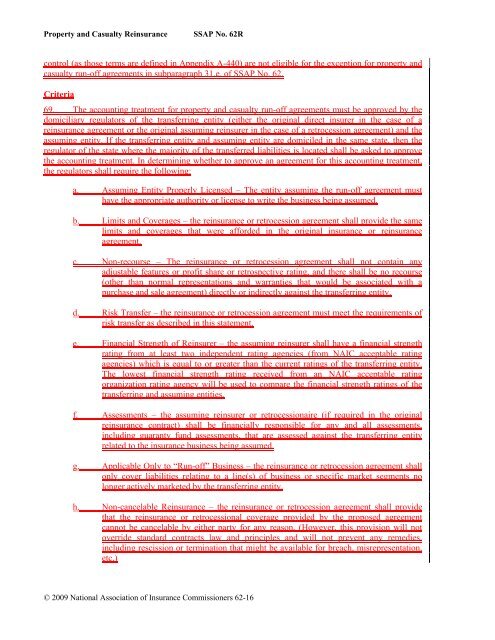
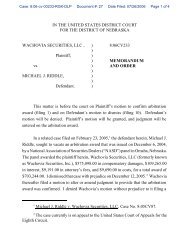
![202 Folio No 734 Neutral Citation Number: [2006] EWHC 1345 (QB ...](https://img.yumpu.com/50015000/1/184x260/202-folio-no-734-neutral-citation-number-2006-ewhc-1345-qb-.jpg?quality=85)
